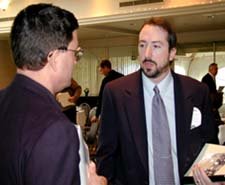|
|

Kevin Murphy talks with Steve Peters after his presentation Friday.
|
Destination 2030 is the name of the regional transportation plan, a comprehensive road map devised by the Puget Sound Regional
Council which is due to be released in early 2001. Kevin Murphy, transportation planner with the Council for the past 4 1/2, years spoke to the BBRC Friday to explain the plan.
“This initiative has been underway for over two years, bringing together four Puget Sound
counties – King, Kitsap, Pierce, and Snohomish – dozens of cities in each of these counties, and cooperative efforts with state agencies,” explained
Murphy. “The Council has set priorities with the task to end the ‘roads versus transit conflict’ and adopt a plan that will carry us out 30 years.”
Studies indicate that the population of the region will become older in 30
years [No kidding?], almost doubling from its present 10%. Single-family households will decrease, while the total population will grow by 1.5 million
new faces. The Destination 2030 plan is a few months away from being finalized, and the Council is soliciting ideas for the first installment, due in March. Three broad alternatives are being proposed:
- Update the existing 1995 plan with funded projects only (least aggressive);
- Continue the 1995 plan and complete all projects; and
- The 1995 plan “PLUS” (most aggressive).
Referring to these alternatives as “options,” Murphy reviewed the three
plans. Option 1 calls for “continuation of the 1995 plan, with funded projects only.” In Option 1, ferry service is largely discontinued after 2010,
local transit service is cut by 25%, congestion throughout the region goes up nearly 50%, and air quality worsens.”
Option 2 calls for continuation of the 1995 plan, but completing all projects
. This preserves ferry and bus service at present levels, increases highway lanes by 1,400 miles, and give more convenient access to biking and walking opportunities.
Option 3 is the so-called “Plus” plan, which envisages more state and local
roads, the next stage of bus, ferries and rail, major regional projects such as I-405, 520 bridge, SR 509, SR 167, use of new technology, and land use/growth strategies.
Obviously, the most expensive plan is Option 3, which Murphy said would
cost taxpayers $33 per month per person in order to fund all projects contemplated. At the same time, the “Plus” plan mitigates the current air quality problems.
Answering a question about current gas taxes, Murphy replied that the
state gas tax is 23 cents per gallon, added to the 17 cents per gallon of Federal tax. “The projects currently listed for completion would cost an
additional $18 billion,” said Murphy. “If you relied solely on the gas tax to fund that expense, it would require an increase of 89 cents on the state gas tax.”
The Destination 2030 exercise is in its final phase of collecting citizen
responses. The Council wants to know what specific projects should be completed? How aggressive should this plan be? How much are you
willing to spend? What should the top priorities be? You are urged to visit the Puget Sound Regional Council’s website or email them with your comments. You may also fax your comments to (206) 587-4825 or write
the PSRC at 1011 Western Avenue, #500, Seattle WA 98104. The Council also maintains an information center at (206) 464-7532.
Murphy noted that the region has “not kept up with its transportation needs
. In the 1970’,s the public said no to various projects that could have lessened the pressures we see today.” The purpose of these proposals is
to give the region(s) the opportunity to fund projects the public determines are priorities. That’s what Destination 2030 is about and its time is now.
Thanks to Bob Holert for his introduction.
|